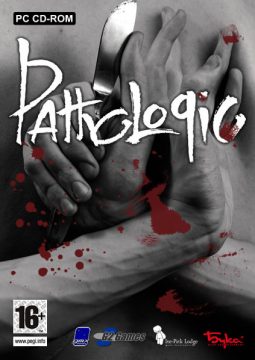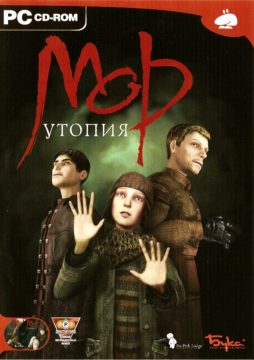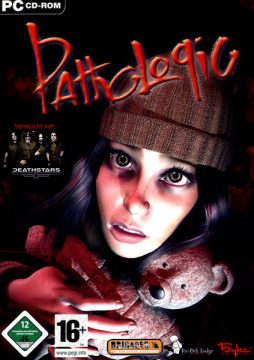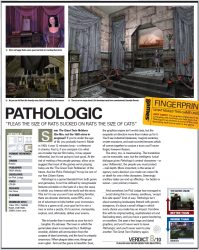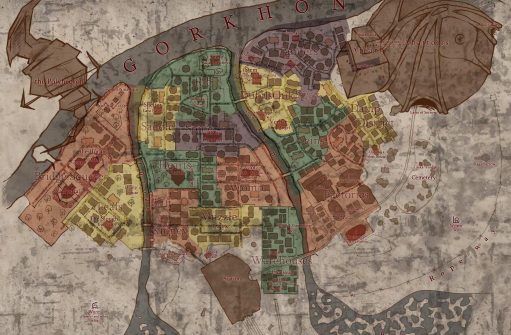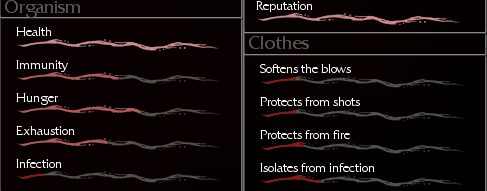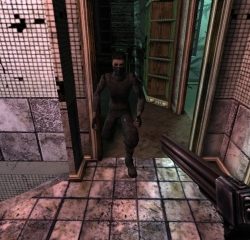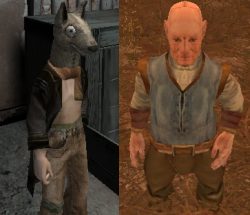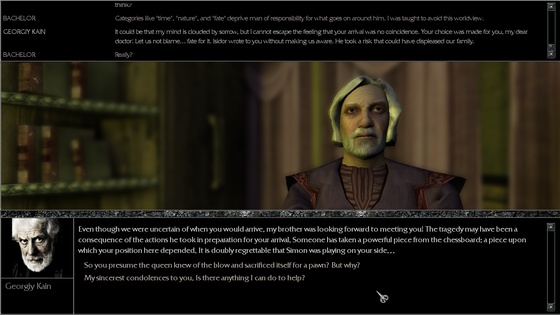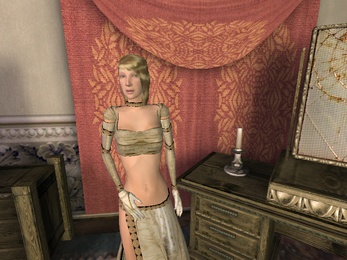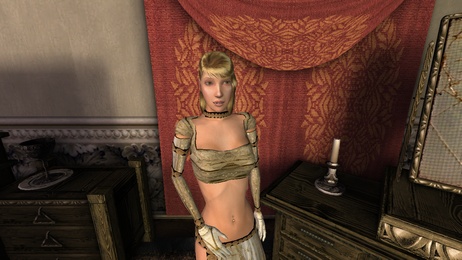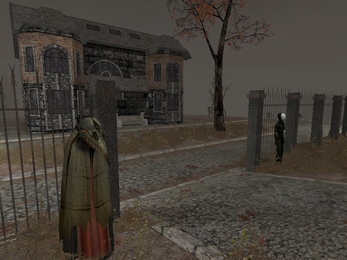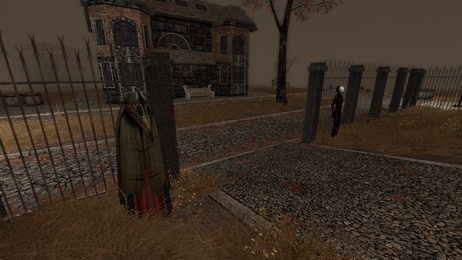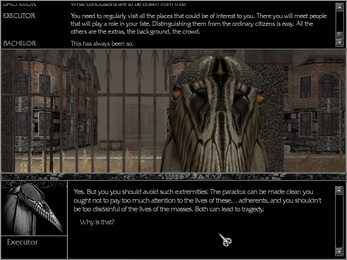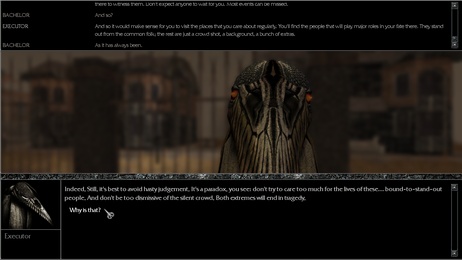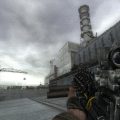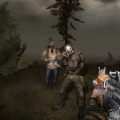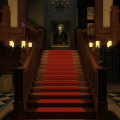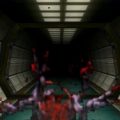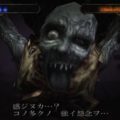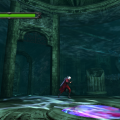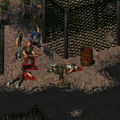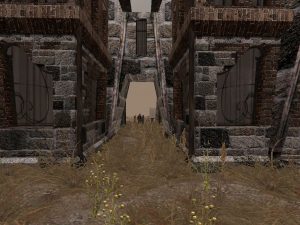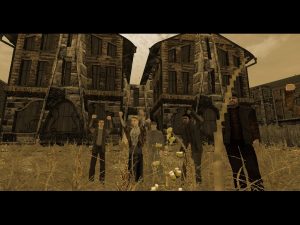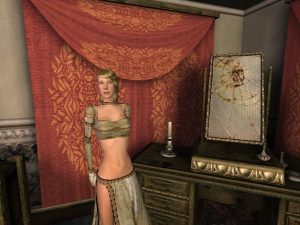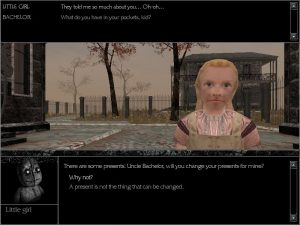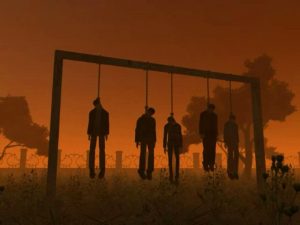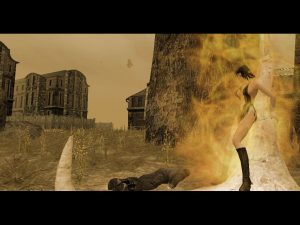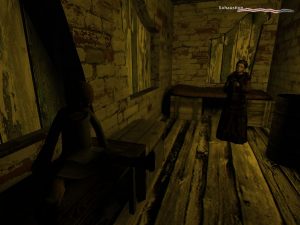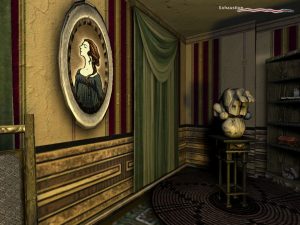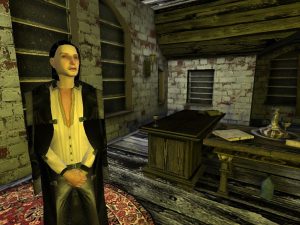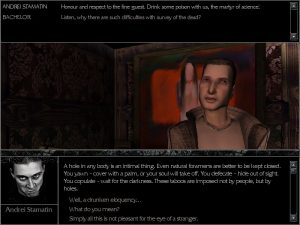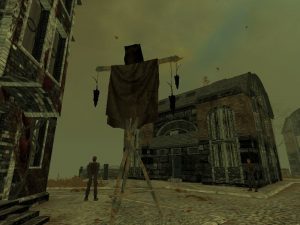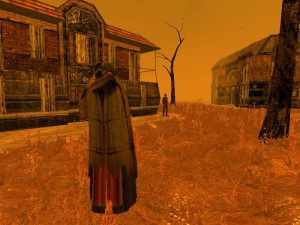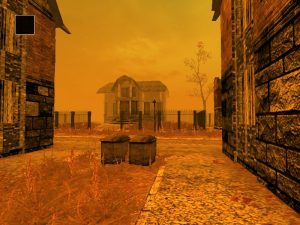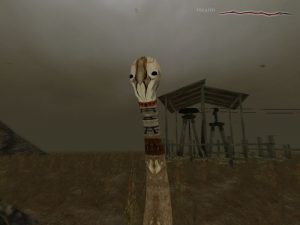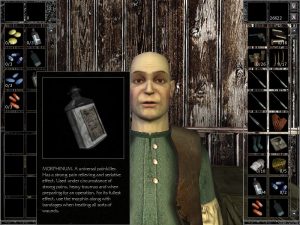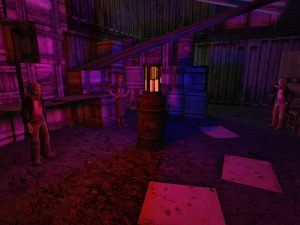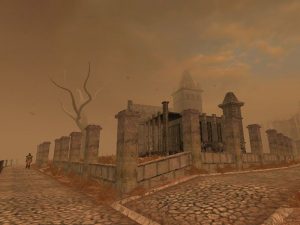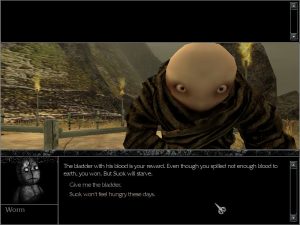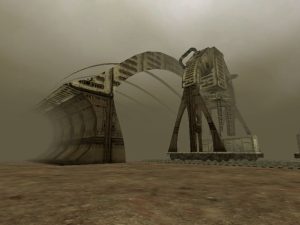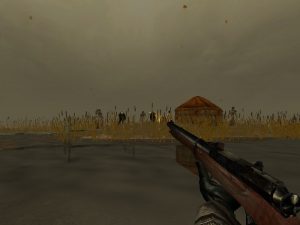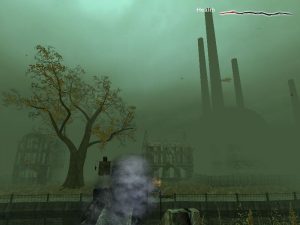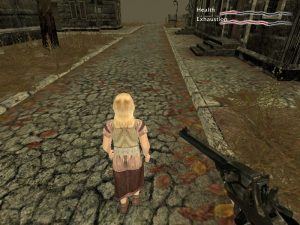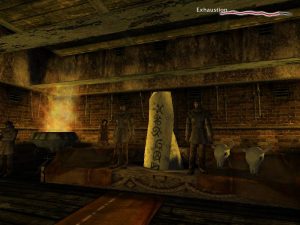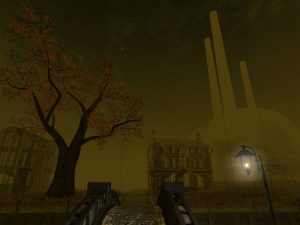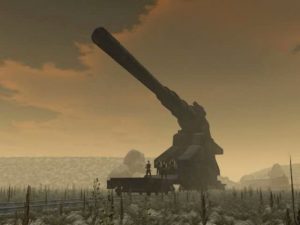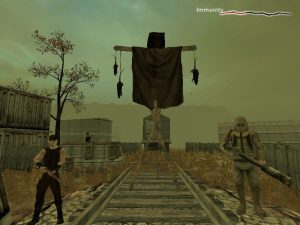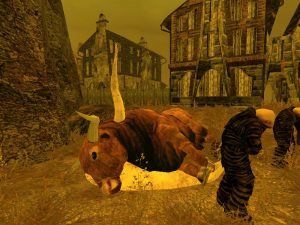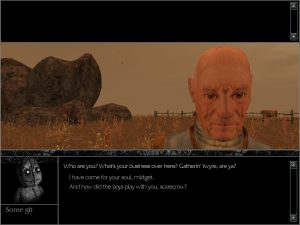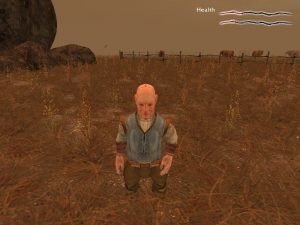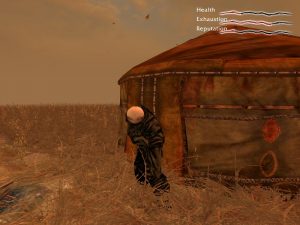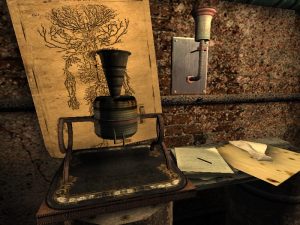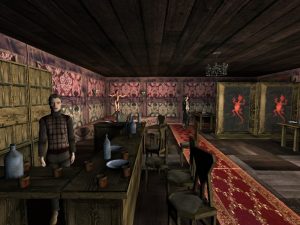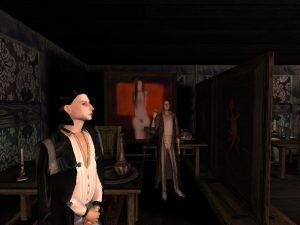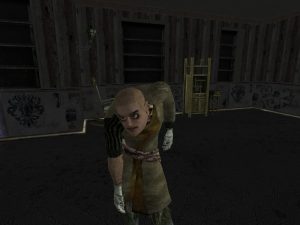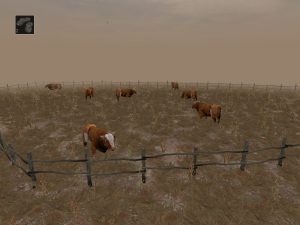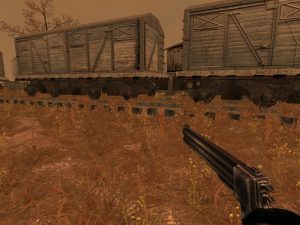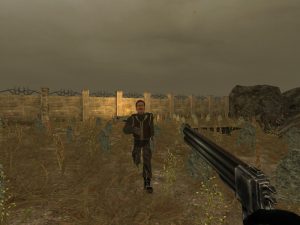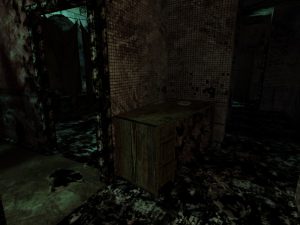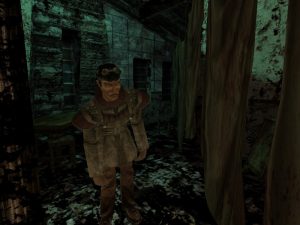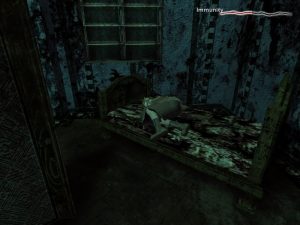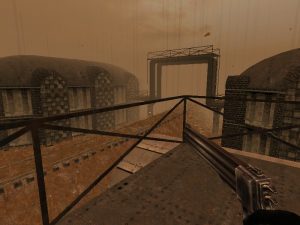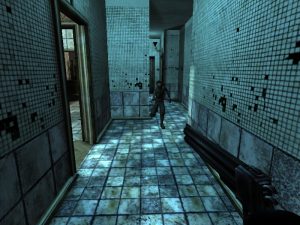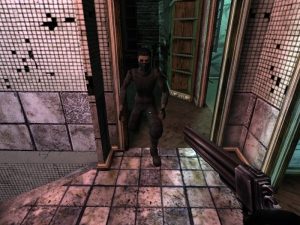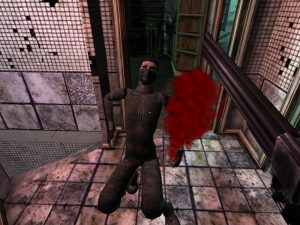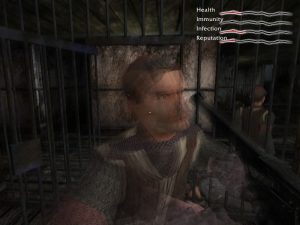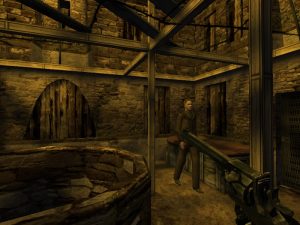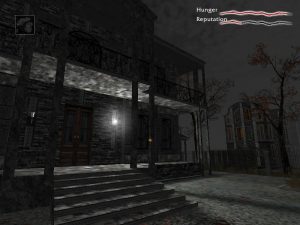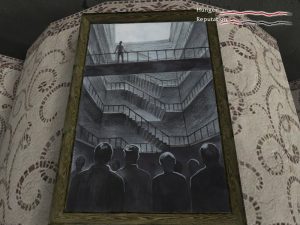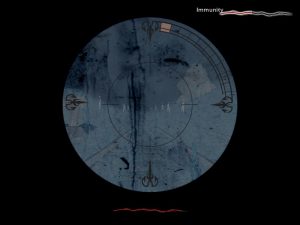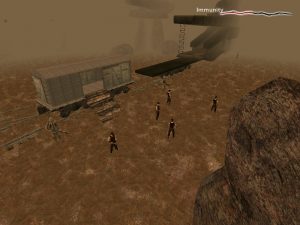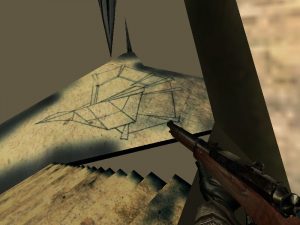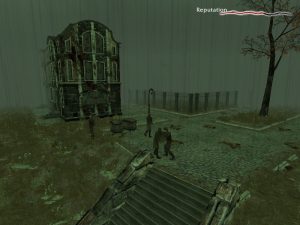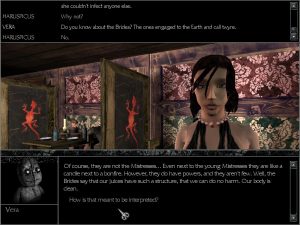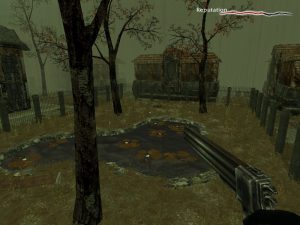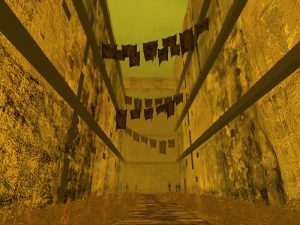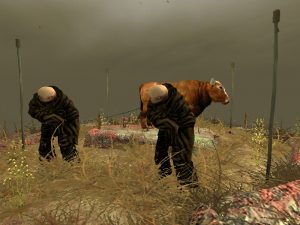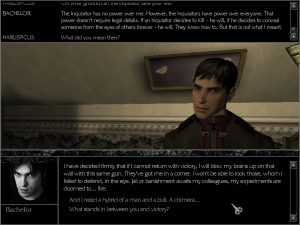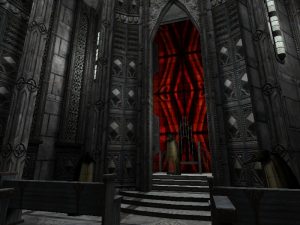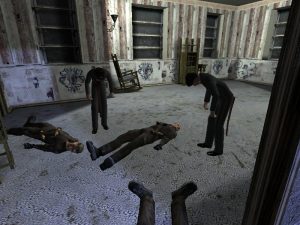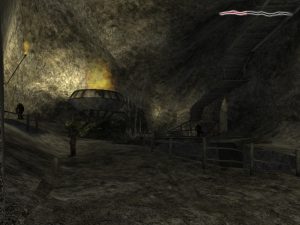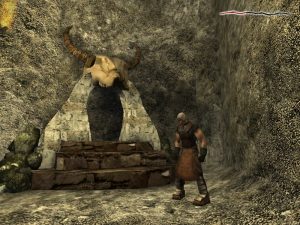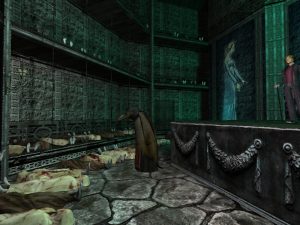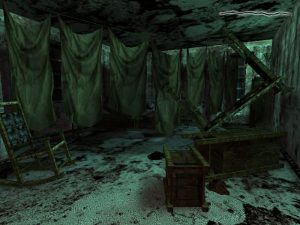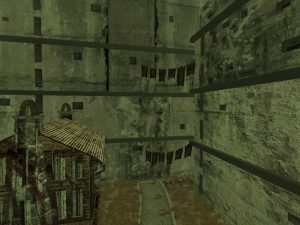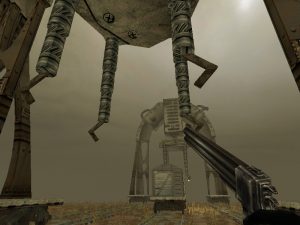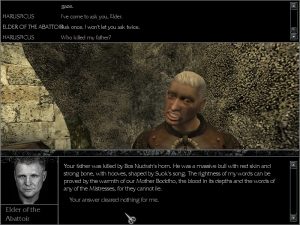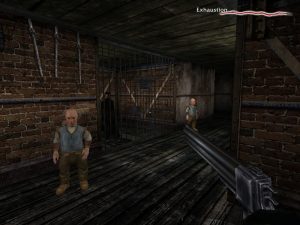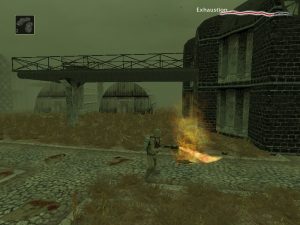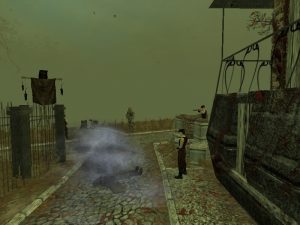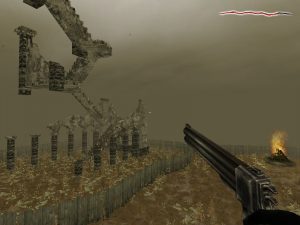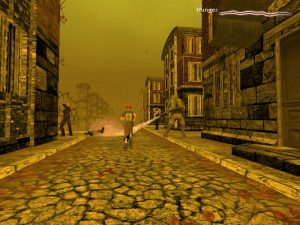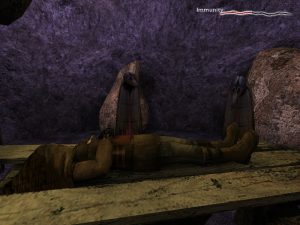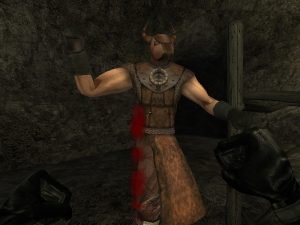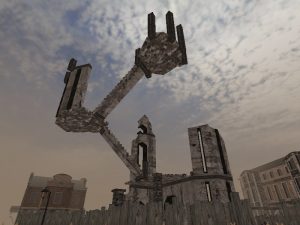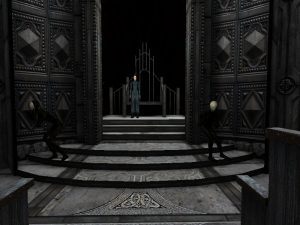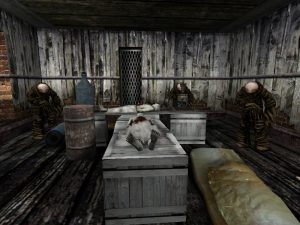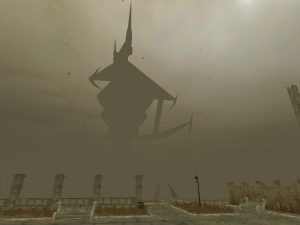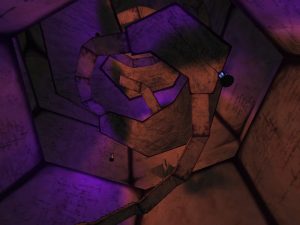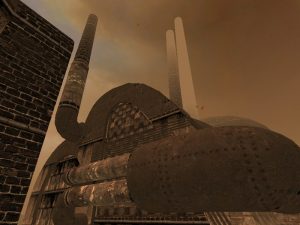Despite visuals that would turn many players away, a complete lack of presence on Metacritic, a Game Rankings score of only 66%, and a generally pervasive feeling of being unplayable, Pathologic by Ice-Pick Lodge has received a lot of praise in some circles. Gamasutra has championed its eccentricities alongside Deadly Premonition, and Rock Paper Shotgun ran an exhaustive three part feature on it. Not to mention all the awards and GOTY recommendations it received in its native Russia. Even so, it’s still a comparatively obscure Windows based game, and one that’s likely to grow increasingly so as the Windows OS makes older software obsolete.
If you’ve not yet had the pleasure of experiencing Patholigic, try to avoid anything which details the surprises it holds. Also, don’t be put off by exaggerated claims of it being obtusely difficult, unbearably archaic, or having a translation which makes it unintelligible. It has flaws, undeniably, but in a similar situation to Deadly Premonition, many of its bizarre quirks are what make it so wonderful. It’s also not particularly difficult, if you stay calm and think. Ultimately, the game let’s you correct any mistakes you’ve made via a rather ingenious system, so even if you fail some tasks it’s still possible to see the best ending. Persevere and you will be rewarded with a genuinely unique gaming experience.
Set in a remote cattle farming town on the Russian Steppe, accessible from only one direction via train, the game takes place over 12 days at some point in the early 1900s. A precise date is never mentioned, but given the presence of an enormous Soviet railway gun at one point, it obviously occurs between the two great wars. One military character even mentions being pulled away from the front, implying perhaps one of the conflicts Russia was involved with just prior to World War II. Regardless, the entire town is gripped by the “sand plague”, which threatens to become a country ravaging epidemic if not dealt with. Players take on the role of either the Bachelor, a doctor from the capitol; the Haruspicus, a returning folk healer; or the Devotress, a mysterious young woman thought to have magic powers and feared by the townsfolk. The main challenge, whoever you choose, is simply to survive for 12 days – actually stopping the plague, and dealing with various characters subplots, is secondary. It’s also easier said than done.
Pathologic is a “survival game” in its purest and most intense form. You need to eat, sleep, avoid injury and, most importantly, avoid infection by the sand plague. It’s actually fairly easy to avoid infection, especially if you abuse the quick save/load options, but getting infected adds an incredible new dimension to proceedings – the regular need to medicate yourself. This entire system meanwhile is facilitated by a constantly fluctuating economy, based around currency and bartering. At first medicine, food, and clothing will be plentiful, but as panic sets in prices will rise, money becomes worthless, and the authorities will start imposing draconian measures to maintain order. You may well find yourself trading in your only handgun for some bread and antibiotics, while outside the store arsonists set fire to anyone they think has the disease.
The beleaguered town is split into a number of named areas (Bridge Square, Tanners, Damp District, etc), divided into three main sections adjacent the Gorkhon River (the river doesn’t actually exist, though is named similarly to the Orkhon River). In the West of the town is the Polyhedron tower, an unnatural almost Luvcraftian structure, floating above the ground and seemingly constructed from the paper upon which its plans were drawn. To the South is swampland and the closed train station. To the East is the enormous Abattoir and Apiary which houses the workers, both locked to prevent spread of the disease. Amidst this hell are 27 key characters known as Adherents, who are distinct from regular NPCs, each with their own agenda. You must deal with all of them in order to survive and bring about a conclusion – though be careful, since in an apocalyptic situation such as this, you can’t really trust anyone. The town is ruled by three opposing dynasties, a triumvirate which balances itself: the Kain family, acting as spiritual leaders; the Subarov family, who deal with law and order; and the Olgimskiy family, who are the financial providers.
It’s a nightmarish story about the struggle between religious beliefs and scientific advancement, between technological progress and ancient traditions. While a plague turns the blood to a consistency like cottage cheese, the devout turn to their gods while the godless turn to experimentation. As the supernatural visage of the demon Shabnak-adyr looms out of the mist, desperate men resort to the trusted technology of gunpowder and lead. The world and its characters exude an aura distinctly East European, surrounded by grim overcast skies, foreboding plains, and cold rust. The indigenous religion of bull worshipping and sacrifice, of rivers of blood kept warm beneath the earth, permeate everything.
Player Characters

Daniel Dankovskiy
The Bachelor. A dandy from the capital, in a snakeskin jacket and with a bag of strange scientific contraptions. Seeking to discover immortality, the authorities condemn his experiments – he visits the town both on their order and after receiving a letter claiming his hypothesis is correct. This is a chance for redemption, but the superstitious townsfolk don’t trust him. Daniel is the easiest character, but also the least interesting since, unlike Artemy, he can’t harvest organs or create serums. His special ability is a looking glass which reveals the disease, but it’s totally useless.

Artemy Burakh
The Haruspicus. A “hierophant” and heir to the legacy of his father, Isidor Burakh, the town’s highly respected mystic healer, especially among believers in the steppe rituals. He’s been studying in the capital, but is called back by a letter from his father, who dies shortly before his arrival. As a hierophant for the local “Bull and Earth” cult, Artemy is entitled by lineage to dissect human bodies. Local folklore believes that cutting along the “sacred lines” allows clairvoyance, while the letting of blood onto the Earth nourishes the spirit within it.

Klara
The Devotress. A mysterious third character who only becomes playable after finishing the game. She’s also the most difficult to play as, since the townsfolk are actively frightened of her, believing her to be an evil witch. This results in a constant loss of reputation which means shopkeepers and NPCs are uncooperative. She can’t use weapons, but is able to harm or heal people using just her hands; healing people increases reputation. Klara starts the game waking up in an open grave, with little memory of how she got there. Catherina Saburova believes she is a prophet.
Kain Family

George Kain
Brother of the recently deceased Simon Kain, and now eldest of the Kain family, one of the three ruling families in town. Brother also to Victor; Maria is his niece. At first he believes his brother was murdered, and requests that Daniel investigate the matter. At odds with the rival Subarov family, he has a liking for Vlad the Elder, since he’s easier to manipulate than the son.
“A bud that is about to blossom out into a beautiful flower. A sun that has already shown the edge of its dazzling crown. We are now waiting for the sunrise.”

Victor Kain
Brother of George and Simon, and father of Maria. He was married to the late Nina Kain, one of the town’s Mistresses, alongside Catherina Saburova and Victoria Olgimskiy. He detests the Inquisitor, who was sister to Nina, believing that she bears a grudge against his dead wife and family. He also has a son, Khan, who has barricaded himself inside the Polyhedron.
“It’s easier to show wisdom in someone other’s affairs, than in your own.”

Maria Kain
Daughter of the late Nina Kain; heir to her mother’s legacy as town Mistress. Apart from being extremely attractive, she also has mystical and spiritual powers of clairvoyance, similar to Catherina Saburova, Kapella Olgimskiy, and Mishka the orphan. She is well aware of the importance of the Adherents, and the need for their survival if the town is to be reborn.
“Within each of these people dozes a certain power which, if discovered, would allow them to break the routines of human existence and become something more than human. I don’t know, I’m not a Mistress yet. The future is vague.”

Khan
Son of Victor Kain, he has locked himself and many of the healthy children of the town inside the Polyhedron. He’s also in charge of the Doghead gang, whose members wear creepy stitched masks that given them a canine appearance. Khan doesn’t play much of a direct role in Artemy’s scenario, but Daniel will deal with him a lot, even gaining access to the Polyhedron, if he’s willing to collect army rifles for his gang.
“Our salvation is in calmness and in silence. To be still, as someone who has teased a nest of poisonous snakes.”
Olgimskiy Family

Vladislav Olgimskiy the Elder
Cattle Baron of the town, and head of one of the three ruling families. Was married to the late Victoria, one of the town Mistresses. He owns the Apiary and Abattoir in town, and is in charge of all the butchers. Is often in conflict with the local religious Order. Vlad is a tricky man to work out, since in both the Bachelor and Haruspicus scenarios he appears to be on your side, but when you play the alternative scenario it becomes clear that he’s playing them against each other. His son is also called Vlad (The Younger), though they don’t get along, while his daughter is Victoria Olgimskiy, also known as Kapella.
“For what am I punished by such children? The girl is good, but the boy – the boy is intolerable! Swines! No, their whims should never have been indulged.”

Vladislav Olgimskiy the Younger
The unruly and always questioning son of Vlad the Older. Despite researching the Steppe people and their strange customs, he cares little for their superstitions, instead believing in science and logic like the Bachelor. Despite local folklore forbidding the digging of wells, he digs one anyway in a secret location. This leads to no end of trouble, with strange noises, a disturbing vision of the Rat Prophet, and trouble with bandits. Not a bad guy, just not someone who willingly plays by others rules. He will happily hire the player to perform arduous tasks for extremely handsome rewards.
“The Apiary is a huge doss-house, within which live… No, rather – nest the workers of the Bull Project. You could call it primordial.”

Kapella Olgimskiy
First name Victoria, like her late mother, and future Mistress of the town. She is wise far beyond her years, and plays a key role in both the Haruspicus and Bachelor’s scenarios. She is often at odds with Klara, the Devotress. Mainly Kapella acts as a surrogate mother to the many orphans in town, helping them out or, more often, arranging for the player to help them out. She has some very strange spiritual beliefs.
“If not for this pestilence, I would spread a pagan cult among the children, and then, the parents would live forever!”
Subarov Family

Alexander Saburov
Head of the Subarov family, one of the three ruling families in the town. At first appearing cooperative and helpful, he soon reveals himself to be power hungry and slightly insane, enacting harsh laws when the plague starts to spread. After a time characters learn that to get anything out of the Saburovs it’s much wiser to go through his wife, Catherina. Curiously, she lives in her own separate annex of the family home, with the two sides having no connecting doorway at all.
“I wanted to return the power and dignity to our country. If I wasn’t for this pestilence, I would probably become governor.”

Catherina Saburova
One of the town Mistresses with magical powers and a morphine addict, she’s just as unhinged as her husband. She is, however, much more amicable and, if you handle the conversations delicately, open to manipulation. Her powers aren’t as strong as the other Mistresses though, and she’s prone to being terrified of the smallest things. She offers Artemy insight into his destiny, and is quite taken with Klara, regarding her as a saintly prophet.
“I need morphine! Is it true that my eyes are like buttons? I feel gripes inside my belly, as if I am filled with straw.”
Other characters

Stanislav Rubin
A doctor and former soldier, wounded in the head at the Storm of Skerries. He was the student of Isidor Burakh, Artemy’s father, up until his death. When Simon Kain dies he steals the body in an attempt to create a vaccine using it. Unfortunately he fails and ends up on the run from the authorities in town, since cutting a body is regarded as sacrilege. He sets up a secret dissecting lab in the warehouse district, and works extensively with Doctor Dankovskiy in trying to find a cure.
“Dissecting of the body by anyone who is not a hereditary menkhu is considered a disgusting blasphemy. In their eyes this is worse than incest.“

Andrei Stamatin
One of the Stamatin brothers; sibling to Petr. Although describing himself as an architect, he’s more like the local drug dealer and pimp. He owns the underground twyrine tavern, bartering the twyrine herbs from the player in exchange for ammo (twyrine is a family of plants native to this area, with various “medicinal” effects). He also seduces the “herbal brides” into becoming exotic dancers – they are revered as holy maidens by the mutant “worm” people, and are able to call up the herbs from the Earth. One of Andrei’s dialogue trees implies that he attended the same university as the Bachelor, and that they know each other. Daniel recognises him as the one who “juggled knives”.
“A hole in any body is an intimal thing. You yawn – cover with a palm. You defecate – hide out of sight. You copulate – wait for the darkness. These taboos are imposed not by people, but by holes.”

Petr Stamatin
Brother to Andrei. A severe twyrine addict and the local insane genius apparently responsible for designing and overseeing the creation of the Polyhedron. Although he doesn’t make much of an appearance in Artemy’s scenario, he interacts a lot with Daniel. The troubling thing is, he can’t ever recall designing the Polyhedron and, given how it floats above the ground, he can’t understand how it’s able to defy the laws of physics. There’s something very strange going on here…
“We are afraid of everything, brother, as all mortals are. And, we want everything. As if immortality is granted to us.”

Aglaja Lilich
The Inquisitor. Despite the ominous descriptions prior to her arrival, the fact that she sends several to the gallows, and most characters extreme dislike of her, Aglaja is actually quite a nice person. She brings order to the anarchy of the town, and helps both Daniel and Artemy in their quests. In Artemy’s scenario there’s also the hint that she maybe has an attraction towards him. Unfortunately she herself is destined for execution, sent to the town by the authorities only as a final chance for redemption.
“He sent an arrow at a worthy target, only for it to strike him in the back…”

Alexander Blok
The Major General – a well respected, highly decorated war hero, with a severe haircut. When Daniel and the Inquisitor can’t curb the plague, the authorities send in General Blok, along with several rifle and flamethrower platoons, plus plenty of railway artillery, all with the intention of destroying the town. His reference to “the front” implies perhaps that the game takes place during or just before WWII. Despite his harsh nature, he’s quite honourable and likeable, with an unwavering belief in duty. He will severely punish those who act unacceptably.
“Whose will has sent us to this plague hole? We are needed now at the front!”

Elder Oyun
Current head of the indigenous religious order which worships bulls.
“He is body of Mother Boddho’s body, his figure is comparable with the Universe. His lines are lines of this world. His white tissues predicts the flow of time, his blue tissues control the rains and water, the brown tissues store warmth. His bones are the bones of mountain ridges. His skull is the sky. His juices are the rivers. His hair – the grasses and roots. His voice – song of Boddho, his semen – happiness for Boddho’s Vein. His black blood is the memory and time of our Earth.”

Gryph
Head of the local thieves, Gryph hangs out at a warehouse near the railway lines and sells pretty much everything that isn’t food or twyrine. Of course his trade-in prices are lower than anyone else’s, and his items are the most expensive. Still, if you need ammo he’s the best place to go. His gang is in constant conflict with Notkin and the children in the Dualsouls gang.
“I reckon it’s more honourable to go about some thievin’ than killin’.”

Anna Angel
Now here’s a nasty character with a dark past. She claims to be a talented circus performer, but there’s a subplot which reveals some disturbing inconsistencies with her story. She has a connection to Var the hunchback, on the other side of town, though he isn’t an Adherent like Anna. He will buy harvested organs off Artemy though. Anna spends much of her time making disparaging comments or plotting again others in town.
“I do not want to undress! What if something terrible is on the skin?”

Julia Luricheva
Residing in an affluent suburb to the north of the town, known as The Rib, Julia is seemingly the perfect counterpart to Daniel, believing in logic and reason. However she also plays a major role in the Devotres scenario, being one of her Adherents. Sickly and prone to paranoia, she will behave unpredictably at times.
“I had to convincingly pronounce the logic of inevitability because I had attained it by my own efforts.”

Lara Ravel
Now here is a tragic character. Lara is one of the most kind-hearted women in town, opening her home as a shelter to those less fortunate, while setting up a monetary fund to help the sick. Unfortunately she’s disliked by several characters. Lara has a sad past involving her father and is quite fearful of what is happening around town.
“I was the kindest. I did not know up until the end that I would have to meet the murderer of my beloved father!”

Eve Yahn
A key figure in the Bachelor’s scenario, she doesn’t feature at all for Artemy. She owns the opulent Slough Manor in the Leafs district of the town, on the far West side, near the Cathedral. Seemingly regarded as one of the beauties of the town, she worries she’s losing her appeal. She also has some very strange religious beliefs, and seems quite easily swayed. She’s quite taken with Daniel, however, regularly trying to seduce him into bed and ultimately falling in love with him.
“You see, my varnish has peeled off. I really wanted to give my soul to our Cathedral to bring at least something immortal to it.”

Laska
The blind daughter of the deceased graveyard keeper, and therefore an orphan. This frail young girl is brave despite her disability, challenging those who attempt to burn corpses, and getting arrested as a result. Doesn’t play much of a role in Daniel or Artemy’s scenarios, but is prominent in the Devotress scenario. According to Kapella, she has an important destiny.
“You won’t touch the poor daughter of the graveyard keeper, will you? If I die, who will look after the graves?”

Mishka
Creepy orphan girl who lives alone in an abandoned railway carriage, near the train station. Like the “Mistresses” in town, she has a mystical gift, and is able to commune with the Earth spirit, through a rather hideous doll. She has an important future, if you believe what Kapella says.
“It’s about the orphan and people that live underground. About gekhken, and the false legs, who dig tunnels to houses… They are these horrible men, like worms. He had to make the false legs love him… Sordid, sordid!”

Notkin
Another orphan and leader of the Dualsouls gang of children. His leg is injured so he hangs out in the warehouses south of Gryph and the railroad tracks. The Dualsouls are often in conflict with both Gryph and Khan’s gangs. For Aertemy Notkin is useful for acquiring new maps every day, showing the spread of the plague through town, detailing which areas are clean, infected or burned out and filled with bandits. It will cost quite a bit though. Notkin is describd as a protector of animals, and gets hysterical when a bull is found injured in town.
“My Dualsouls are everywhere, watching for enemy Dogheads, catching Souls, and just hangin’ around.”

Ospina
A wretched witch according to the Bachelor, spreading nothing but evil. She doesn’t trust his science, believing it will bring death and ruin to them all. Be wary of her if playing as Daniel. To Artemy the Haruspicus however, she is an obedient aid and protector of his father’s legacy, openly admitting her love for him, “as a slave would love its master”. When the Apiary is quarantined she shelters the runaways, protecting them from the authorities that would harm them. She has an incredible knowledge of the arcane mysteries of the Steppe and its people.
“It is made of clay, bones and blood. It looks like a person full of bones. The Steppe gives birth to it, when the Earth needs a weapon to fulfil the destiny.”

Spichka
This orphan lives in a poor part of town near the Abattoir. Refusing to join either Notkin’s Dualsouls or Khan’s Dogheads, he goes about creating mischief on his own. He does, however, have an expert knowledge of the town’s layout and secret hiding places. He’s also slightly obsessed with the Steppe and the supposed supernatural creatures which roam it at night. Most of though he just gets himself into serious danger, requiring you to bail him out.
“Have you met at night such pale and glowing man? The cat knows what meat she has eaten!”

Taya Tychik
This mysterious girl is also known as Mother Keeper. She’s the extremely young daughter of someone formerly in charge of the Apiary. Previously living inside the Polyhedron, she left and is now trapped inside the Apiary. For some unknown reason she is regarded as the “sacred child” who all the Steppe inhabitants in the Apiary obey. This causes some difficulty when you need her to do something, since she tends to do what she wants. The inhabitants of the Apiary treat her like a small goddess, protecting her, but they won’t let her leave. Disturbingly she has the power to judge and sentence to death anyone who offends the Order.
“They show me nothing, they do not let me out of here! If to incline me, the right eye is not fully closed.”

Mark Immortal
In charge of the theatre, which is later converted to a hospital and then makeshift morgue. He doesn’t play much of a role in the game itself, but he is an Adherent. Between midnight and 6am every night Mark organises a new stage play which looks at the events of the preceding day. It’s well worth quick-saving and then making the trip to view these.
“I am honoured to introduce myself – Mark Immortal, impresario of the Theatre and master of puppets. Does the honoured one wish to see the pantomime?”
The town within which Pathologic takes place…
Although it looks like an FPS, Pathologic is closer to a classic adventure game, with locations housing static characters that need interacting with to open up new avenues. Each of the 12 days has several secondary tasks, brought to the attention of the player via letters delivered throughout the day. Usually they involve visiting one of the above characters and performing a task, such as collecting medicine, delivering rifles, killing a group of enemies, or questioning someone. These can be ignored; secondary tasks usually but not always grant some nice rewards. Alongside these are also a single, primary task for that day, which tends to be more involved. As the bachelor for example, you might have to prove that a group of people aren’t infected, visiting each in turn. As the Haruspicus it could be completing a test set by Elder Oyun, such as killing a trio of butchers while enduring increased hunger. Failure of a primary mission doesn’t end the game, rather one of that player character’s Adherents will get ill. Each of the main characters has a pre-assigned group of Adherents they need to keep alive until the end of the game, and failure to do so prevents you from accessing that person’s main ending. If all your Adherents are alive you can enter the final and conclude things.
Here’s where the ingenious part comes in though – and is the reason why the game isn’t as difficult as most reviewers claim. Up until and during the 12th day, any Adherent which is ill (due to a failed mission), can be cured of the plague using a one of two rare items. During certain story missions players will be able to collect vials of panacea – and one-use cure all. There’s about five available for both Daniel and Artemy, depending on how well you do. Alternatively, the very young girls which inhabit the town will have items for trade, including sometimes “children’s powders”, for which she’ll want trinkets like pins, flowers, beads, nuts and so on. There’s a whole sub-story to the creation of these powders, and while they damage the health quite severely, they do cure the plague and can be used on Adherents. It’s quite possible to fail several primary tasks, and yet still have all your Adherents alive at the game’s end. If you’ve played especially well, you can use your panacea and powders to save the Adherents of the other two characters, then invite them to the final location and choose their ending instead. This is a fantastic system, since an especially good player only needs complete the game once to see each of the character’s unique endings. Whatever happens, always strive to acquire the children’s powders. That way if you screw up, it’s not a complete loss.
The endings deserve special mention, since there’s another ingenious layer to things. Along with three endings (one for each character), and a general “failure” ending, there are two bonus endings: bonus ending A is acquired for saving all the Adherents of a second character in addition to your own, and ending B is accessible if you save every Adherent in the game. The B ending isn’t that interesting given all the work it requires, but bonus ending A contains quite possibly the greatest, most mind-blowing twist in the history of videogame endings. It’s not entirely original, similar themes have been used in books and films, but it’s handled with tremendous subtlety here. Afterwards you realise there were several hints throughout the main game, and it also explains some otherwise unanswered questions. It is well worth working towards.
Can You Survive?
Overlaid on the adventure aspect, and masterfully intertwined with the narrative, is the previously mentioned survival system. The sad thing is, while the complexity of such a system used to be common place in PC gaming, today it’s regarded as archaic and isn’t seen so much (there are quite a few decent indie games though). A good comparison would be to Robinson’s Requiem, while more recently the STALKER series features a similar style of bartering system, albeit with toned down survival mechanics. At its most basic, Pathologic requires you constantly administer enough survival items; it’s a mixture of resource management and damage control, because as time progresses you are constantly “decaying”. Hunger is easy enough to manage, since you just need to buy and eat food. Exhaustion is diminished through sleep, though be careful because your hunger goes up. If injured through fighting, you can top health up through medicines, which increase exhaustion, or tourniquets and bandages. One of the drugs you can get, Meradorm, is actually best administered before bedtime, since it causes health to increase while sleeping. You can drink coffee to stave off the sedative affects of the antibiotics, but this is bad for the health. Lemons will wake you up, but they increase hunger so you need more food. The best element though is when you become infected.
Getting infected is based on your immunity level – the higher the immunity, the less likely you are to catch the disease when walking through “plague clouds”. You can increase your immunity through drugs, but these damage your health, so be careful. Once infected, the growth rate of the infection is suppressed by your immunity level, which dwindles as the infection increases. Once the infection reaches a certain level (maybe about 15%), you start to lose health, slowly at first but increasing with the infection rate. Things now require strategic planning. Curing the disease requires one of the two rare items best saved for Adherents, so instead you need to manage the disease. Before bed you should administer immunity boosters to slow the infection while sleeping, then take antibiotics to lower the infection level to minimum. Both of these will take massive hits on your health and increase exhaustion, so you then need to administer Meradorm to restore health while sleeping. A quick snack and it’s time to sleep. You can medicate yourself during the day, but you’re going to be feeling the effects as you run errands around town. It gets exciting though when the medicine runs out, the chemists are empty, you’re low on money and supplies, and suddenly you’re standing in the middle of town with nothing but a revolver and two bullets, and you’re thinking to yourself: “I’ve got a fever, I desperately need to sleep but I can’t, because I’ll probably wake up dead if I don’t get this damned infection under control!”
Although resources are extremely scarce, there are several methods for acquiring them. The simplest is bin raiding. Most contain empty bottles, which can be filled with water and traded with hungover drunks for bandages and tourniquets. These in turn can be bartered when shopping at merchants. Buns also contain broken pocket watches, beads, shaving razors, and discarded trinkets, like bangles and rings. All of these can be traded with the children wandering around town, who all seem to have gotten into their mother’s medicine cabinet and father’s weapon drawer. Basically worthless junk can be traded for drugs and ammo, which in turn can also be bartered. Some of this junk can also be bought from the barman at the tavern. As Daniel you can try looking for the twyrine herbs that grow all over the place, and then trade them with Andre at the tavern for ammo. Artemy has a unique ability, since as a hereditary menkhu he can dissect bodies and harvest organs – quite legally. These can then either be traded with the humpback in town for bandages and tourniquets, or with the worm people for twyrine herbs. Artemy can use the herbs to then create immunity boosters, or trade them with Andre.
A good source of items is people’s houses, which connects with another system of the game: the spread of the disease. Each district starts off clean, later becomes infected, and then afterwards is “sterilised” after the disease burns itself out. People still live in the clean areas and lock their doors, but you can buy or trade lockpicks, which allow you to break into locked houses and steal stuff – though if the occupant sees you they’ll attack. In infected districts the doors are open, but inside everything is disgusting and covered in filth, with plague clouds which can infect you. If your immunity is high, and you have protective clothing, you can risk raiding these places. There’s also dying people lying around, groaning. You can use some of your medicines on them to ease the pain, which will increase your good reputation. In sterilised districts, where the disease has burned out, everything is clean, but there’s a serious risk of bandits which roam the streets. Inside the houses, which are unlocked, you’ll encounter marauders, who will converge on and kill you if you don’t blow their brains out first. By this time the pickings in houses are pretty slim. The enemy bodies however can be looted for items and, if playing as Artemy, organs. Bandits carry razors, marauders carry crowbars, and arsonists carry Molotov cocktails. All of these in turn can be traded with the patrol guards for food, since they appreciate your help.
Completing secondary quests also often gives resources as a reward. Astute will players will therefore plan out the day’s objectives, minimizing backtracking and time wasting, because there are only so many hours during the day. Bins will be raided en route, houses looted, bandits killed, and every store you pass traded with. A lot of places are out of stock, and there are some truly insane price fluctuations, all of which threaten to leave you on the brink of death. Sound advice would be not to place your faith in currency, but rather valuable items. Along with the key characters are also various NPCs: drunks, metal workers, seamstresses, soldiers, bandits, arsonists, disinfectionists, merchants, and the disturbingly mutated “worms” who wander around draped in rags. Most can be traded with in some fashion, apart from the army people, while the metal workers can repair damaged weapons, and the seamstresses can repair your protective clothing. The whole of Pathologic is a series of complex and intertwined systems, all of which are surprisingly well balanced.
Very few games if any deal with illness or disease in interesting ways. If they do, it usually behaves like poisoning in old RPGs, dropping your health until it self-cures or you take an antidote. Dead Rising 2 introduced Zombrex, but it was a restrictive system and more like a lock-and-key puzzle with window dressing. Most games also don’t have economic systems. They allow you to buy and sell crap, but there isn’t the feeling of a functioning economy. Prices are always the same wherever you buy/sell something, and they seldom fluctuate. Games like Fallout 3 will try to fool you by having a bartering skill which affects prices, but this is simply a number which deviates the standard base price until you’ve built up its levels. As you increase your barter level, the price goes down. In coding it’s something like this: BASE PRICE + (100 / BARTER LEVEL). The old space trading game Elite had a fairly good economic system, with variable prices, but none of the goods you dealt in were of any significance to the game itself – they were just things you hauled. Some games do interesting things, but they’re few: STALKER has a cool trading system, but it actually appears to be based on Pathologic‘s. Metro 2033 allows you to use special bullets as currency, but the result is you never want to use these for combat. Pathologic has a far more gruelling economic system. It attempts to mimic the hyperinflation found in Germany after the first World War: when you start, food prices are cheap, but as news of the plague spreads people start panic buying and food rises tenfold. A small fortune suddenly can only buy one loaf of bread. Random hoarding is also a bad idea, since prices can suddenly drop; the game forces you to think about your actual needs when planning ahead.
All of this intertwines with a marvellously grim atmosphere. On the first day I found the villagers burning a local woman they accused of being a clay witch who murdered the town head, Simon; after she failed to harden and crack, they admitted they were mistaken and so set off to find the real clay witch. Life it seemed, was cheap out in Russian Steppes. On another day some idiot destroyed the town’s only water supply, because he’d been told to boil water to kill bacteria and so assumed that all water was dangerous – thousands would now be short of water in a time of epidemic. And so it went on, dealing with madmen, tyrants and a town of uneducated cattle workers. Pathologic, from start to finish, is a game of futility, desperation and grimacing through difficult periods. Illness, hunger and exhaustion almost become tangible as you crawl down a filthy alley, clutching a half-broken army rifle and mumbling to yourself to make it to the next house. Everyone appears to be a lying, self-serving bastard, you question who to trust, and by the time the army arrives towards the end, bringing with them their own brand of Soviet justice, you quite relish the idea of everything going up in flames courtesy of General Blok’s heavy artillery.
The Alphyna project is an attempt to recreate Pathologic with real world photos.
A lot of people are put off when reading this, arguing the game doesn’t sound like fun. Mario is fun. But videogames can cover, quite genuinely, absolutely anything. Not all games need to be fun – this is a limited mentality which we need to break out of. It might not be fun in the traditional sense, but there can be tremendous pleasure in experiencing a false, orchestrated desperation, safe in the knowledge it isn’t actually real. Pathologc is one of only a few precious games which comes anywhere close to being a facsimile of real disaster.
The game is not expensive. If you’ve read this far and are intrigued, even slightly, by anything that’s been typed, then you absolutely should try Pathologic. It deserves to be experienced as much as possible and, importantly, learned from. Even if you stumble through each day and only end up with the failure ending, it’s worth your time. Of course with such emphatic recommendation there’s also the list of legitimate (and not quite legitimate) criticisms.
Imperfect World
The most obvious is visual repetition. Despite a multitude of districts within the town, all with exotic names, they all look the same. There might be some slight variation, but whether in the rich or poor areas, there’s just not enough variety between the buildings. Only the factory and warehouse areas look significantly different. It would have been nice if each district in the town had its own unique set of textures tell immediately tell them apart. Another easy criticism is the AI – there simply isn’t any. Characters are either ON or OFF. When they’re ON they run at you in a straight line, attacking when close enough. When OFF they don’t. That’s it. Enter a house with a marauder and he runs right at you. Bandits and rats outside meanwhile will wander aimlessly until you’re close enough, then charge right at you. If there’s several bandits, they’ll run at you in single file. As mentioned though, Pathologic isn’t really an FPS and combat should be avoided as much as possible due to scarcity of bullets.
Most critics also bring up the Russian to English translation, claiming it ranges from adequate to unintelligible. So much so that fans on the Ice-Pick Lodge forums banded together to retranslate the game (the plan eventually collapsed). Comments from native Russian speakers on the forum claim that the original game is incredibly eloquent and well written. The translation certainly isn’t. Apart from spelling mistakes, missing words, and obviously incorrect grammar, it flows with the lyrical jauntiness of a madman. As others have said, when most languages are mistranslated, you just get nonsense. Japanese to English produces a humorous “Engrish” which is no substitute for an accurate, authentic, non-literal translation. When Russian undergoes a rudimentary translation it seems to take on a lunatic, almost poetic grandeur.
In the context of the hellish world that Pathologic presents, it fits rather well. While the English translation doesn’t provide the same experience for a native English speaker as the Russian original provides for a native Russian speaker, it has through fate or luck managed to create something worthy in its own right. The majority of dialogue in the Bachelor and Haruspicus scenarios can be understood well enough to complete tasks (reports from the Ice-Pick forums claim that the Devotress scenario ends unplayable later on). The flaky translation though adds to the eccentric nature of the town, to the oppressive nature of the environment. All three player characters are in an unfamiliar place, even Artemy who grew up in the town. The game was published with the translation it received – this is how it is. It’s not perfect, but it adds a certain charm, and it’s difficult now – as an English speaker – to imagine the game otherwise. Most likely if retranslation were to occur, it would sanitise a lot of the game’s character. It also has to be said, that despite its translation, the game manages to make you care about its weird cast, even the NPCs to a degree. At first you’ll question the morality of stealing from people, or killing the innocent for their organs, but the game pushes and then breaks you like a pencil – true nihilism in the end, where any means is justified by the end.
Censorship
According to posts on the Ice-Pick Lodge forums, in the original Russian version you could kill certain Doghead teenagers – allegedly. In the Western release these few were apparently replaced with aged midgets to avoid controversy. The other children you encounter, regardless of region, are immune to attack (there’s a clever reason for this, explained in the secret ending). It’s worth noting that the original Deus Ex (June 2000) allowed you to kill the homeless children around New York, though that game was developed at a comparatively more innocent time, when such content would have been slightly less sensitive.
Coupled with the games translation is the problem of its slow speed. As someone pointed out, its esoteric nature isn’t the problem, rather it’s the slow pacing. With a confusing avant-garde film you can rewatch it a few times in quick succession, whereas Pathologic will require a few days, if not weeks, of regular playing. A conservative estimate would be a single play through requiring 10 hours. Most of the time you’ll be walking between areas that contain dialogue trees, rather than fathoming them. There’s no run button and your character does admittedly move slowly. Increasing your speed isn’t the solution though. The entire game has been expertly balanced and measured to derive maximum desperation within the mission objectives, while still make them achievable. There is a cheating method to massively increase your speed – but this actually detracts from the game. Time is as valuable a resource as bullets or bread, and neutering the slow nature of your character removes most of the challenge. As I said at this article’s beginning, the game’s supposed negatives tend to be the very things which make it interesting. The satisfaction comes from stopping midday, and juggling the needs of a severe survival system, with two or three tasks which will take you across the entire town several times. Your speed is limited, at best you can make two trips maybe a third, as are your physical resources. An astute player will quickly set about making precise plans to weave between certain streets so as to maximize character interaction and the visiting of shops.
As you can tell, the game threatens to become extremely difficult if you’re not planning ahead. If you exploit its systems things become quite manageable. However, there are a few cruel instances where the game is unnecessarily tough. For one mission with Artemy, for example, he needed to get hold of an infected heart. The mission resulted in three infected hearts, two of which were leftovers. A later mission required you feed an infected heart to cow, except the game refused to recognise those acquired from the earlier mission, simply because they were “story items”. This meant a long trek back to an infected district in town, simply to harvest a “regular” infected heart, wasting precious time. It’s also annoying that a lot of secondary tasks give no reward whatsoever. No money, no items, and if it increases reputation it’s negligible. This is significant, because you’ll likely end up using large amounts of resources just to complete, which only results in a generic “thank you”.
Negatives aside, this is a game well worth checking out. If you want a basic experience, try the Bachelor scenario. If you’re up for something a little more unpredictable, go with Artemy, since he ends up jailed, has a tougher time avoiding infection, and is required to perform a couple of tests while enduring increased exhaustion and hunger. If there’s nothing listed in your quest log, hang around to see if you receive any letters – most quests start with a letter. If you get infected don’t despair, just keep a good supply of meds close to hand. Almost everything about Pathologic is the antithesis to what is regarded as good game design today. It’s difficult, unforgiving, esoteric, extremely complex, utterly confusing at times, and it makes no apologies about it. Understanding the game, is part of the game itself. Likewise, at no point does it ever provide any kind of power fantasy – at best you’re in a stalemate with the odds it pits against you. No large publisher today would greenlight such a project, because most players want their games to act as a dopamine button. Press X to Jason feel good or empowered. Even Dark Souls, which is often highlighted as a game with real challenge, allows the player to slay the dragon if they’re good enough. In Pathologic if you’re good enough, you probably won’t starve to death.
(If you’re still really stuck, here’s a guide, with a detailed map, brief quest list, and detailed walkthrough)
Remaster, not (yet) remake
In 2014, Ice-Pick Lodge ran a crowdfunding campaign meant to help them finally address some of the issues and create a complete remake of Pathologic. While that is still in development, the developer has teamed up with Devolver Digital to bring a carefully remastered version of the original, dubbed Pathologic Classic HD. This is still fundamentally the same game with the same flaws and features, but includes support for control pads and widescreen resolutions. It also adds a range of modern shaders and lighting options, and most of the textures are polished up and rendered in higher detail. This is most notable on the ground and interiors, which now look much nicer, while the appearance of characters and buildings seems largely unchanged without comparing them directly.
But the remaster’s major raison d’être is the revised translation. It fixes a lot of the parts that were simply translation errors or bad English, but many of the former version’s critics will be surprised of how little has changed – aside from some restored passages that were simply cut from the former English release, it’s still the same script at its core and more than anything confirms that the plot was really meant to be (almost) as cryptic and confusing as it was.
When faced with the choice between Pathologic Classic HD and the old version (which has been integrated with the remaster even on GOG.com, so now it’s not easy to buy on its own, anyway), this new option certainly is a lot prettier, but also has higher system requirements. At its core the program is very poorly optimized, so you cannot expect the HD version to run well on ten-year-old computers. Due to the way strafing and turning around work, both of these actions also feel just a little bit awkward and not quite right in a widescreen view.
Understand anything yet?
Links:
Rock Paper Shotgun – An interview with the developers, Ice-Pick Lodge.
Pathologistics – Excellent fan-blog chronicling the playing through of both the Bachelor and Haruspicus scenarios, with insightful historical facts and graphs! Contains catastrophic spoilers.
Alphyna A LiveJournal entry (in Russian) attempting to recreate Pathologic using real world photographs taken in the wilderness. As chilling as it is beautiful.

